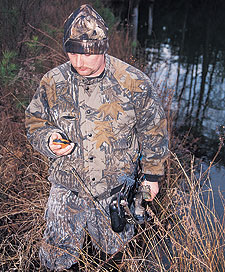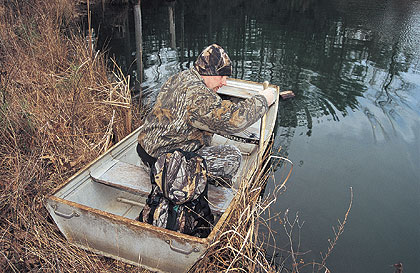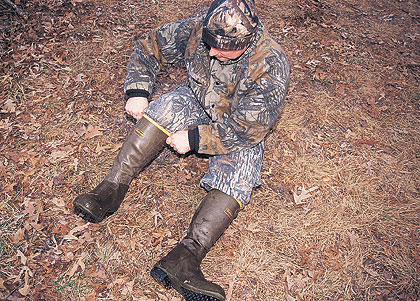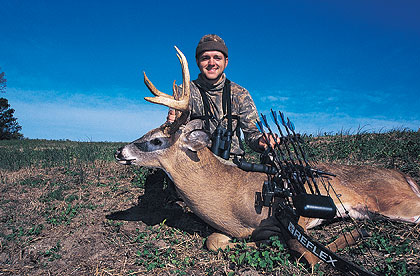October 28, 2010
By Jason Butler
 Hunters that seek out river bottom hotspots are wise to use a GPS unit to mark potential stand locations, to not only prevent getting lost but also to adapt to the changing conditions that are sometimes encountered in these areas. |
The cold, dank evening was winding down like an oven timer as the sun began to droop. The clouds quickly grew thick as cotton candy plugging all holes that were left of beaming light. I'd yet to see a deer from my river bottom tree stand, even though buck rubs and scrapes covered the ground all around me like cigarette butts in a big city landfill. I was beginning to wonder if there were any deer around here at all despite the dreamy buck sign surrounded my stand. Then it happened€¦
A snap followed by a pop. I swiveled my head like a peacock to investigate, and dropped my tongue! The dry leaves would crackle like a size-thirteen boot treading on broken glass when you stepped, but there a buck stood. I expected to hear deer approach from way off before I'd ever see them. I shuffled sideways, latched my release aid onto the loop, and steadied. Shooting light was near zilch.
Advertisement
As best I could I went through the motions: pick a lane; pick a spot; range; breathe; hold steady; easy does it. The heavy aluminum arrow thudded dully off the bowstring and arched through the air, followed by a hollow thump! The next morning I came back with a friend and took up the blood trail. The buck was 100 yards away, dead as a hinge. It was a great feeling.
 Accessing river bottom stand sites can be difficult. Employing the use of a johnboat or canoe can give archery hunters the means to get in and out quietly and quickly. |
The thought of river bottoms turns noses for some. They can be a whole lot of work to hunt. River bottoms are muddy, wet and thick. Bugs and snakes are around in the early season.
Advertisement
Many areas are overgrown with vegetation and second growth brush woven tight enough to squeeze the windpipe of a chipmunk. It's all true. But no matter the challenge for the hunter, both bucks and does frequent these hideaways. Let's examine some key methods for getting the edge on these reclusive deer.
River Bottom Terrain
River bottoms are usually flat and expansive. Bottomland features dominate these areas holding water in pockets and flowing streams cutting off both sides of the main water system. Some areas have small, large and enormous tracts of hardwood land sewn directly into the mix. Other areas have a small amount of timber and more water. Bucks often bed on dry islands or raised areas surrounded by the water and soil. Any predator approaching can be heard splashing from a distance. A safe haven for sure.
Maps
River bottoms are not typically walking friendly. The last thing you want to do is walk aimlessly through the mud, killing both time and energy. Maps shine on both counts. Websites like www.terraserver.com, www.usgs.gov and www.mytopo.com make the task of finding good maps easy. Buy both a topographical map and aerial photo and go through them with a fine-toothed comb. I never climb out of my truck near a river bottom without maps.
Since river bottoms are generally flat, you don't have conventional ridgetops, saddles and benches that influence deer movement so well. Generally I look for three things in terms of stand locations: funnels, ditches and edges. Find as many of these as you can and lay out your stakes. Like every other new piece of hunting property, funnels come first and are easiest to see. Funnels are especially attractive where two large tracts of land connect through a single narrow strip of timber in river bottoms. Even small patches of timber that bottleneck will produce buck sightings.
Ditch crossings are also fantastic setups. Occasionally you'll find a shallow or deep ditch with a well-pounded deer trail running across it somewhere that's huntable. I'll walk these ditches from one end to the other with my eyes peeled. A good hunting buddy of mine loves hunting ditch crossings in river bottoms. His favorite, a shallow ditch holding about a foot of standing water runs north-to-south for several hundred yards. The woods are feverishly thick on the west side and semi-open on the east.
 It's no secret that river bottoms can be muddy, mucky messes. Good knee-high rubber boots are a necessity in most situations. |
He's caught deer coming back in the morning and coming out in the evening from his fixed stand up the bank on the east side. There's rarely a hunt when he doesn't see a deer of some sort. Several seasons back he missed a typical 10-point but later connected on a slightly smaller eight-point. Edges in river bottoms are no different than other edges such as an open field meeting hardwoods.
This may be a timbered section rubbing up against another piece of property that was cut or thinned not long ago to form a neat little borderline that bucks relate to when traveling--a river bottom jewel. In river bottom country I sometimes stumble into areas like these by accident. Occasionally you can pick one up on an aerial photo but not always. Topographic maps don't show this structure at all.
Water
Water can be very attractive, and its influence on deer dramatic. Wide riverways and meandering streams can funnel deer movement beautifully. Water also makes access more difficult. Swamp-type hunting almost always requires knee high rubber boots. I hunt two stands that require me to use a small johnboat and paddle across a 12-foot deep stream. Both stands are worth the effort. It gets me away from the crowd and into some deer-dwelling hot spots.
Water bearing areas such as river bottoms also hold an abundance of aquatic vegetation and other soft mast like berries, wild grapes and fruits. Deer are excellent swimmers and drink water at least once a day. Deer do not hesitate to jump a river or smaller body of water to escape danger. Water can also impose challenges when tracking deer. Blood can sometimes get lost, though muddy areas often reveal easily seen footprints that sometimes can be just as good.
Getting a deer out of one of these spots, depending on where he falls, is sometimes a treat. A deep river bottom tracking-job is easier accomplished with two people. A
deer cart can be tough to use and dragging a deer out should be the last resort. Cut a pole and hoist the deer and let your buddy help you. This will make the job easier and keep the deer from getting drenched with water and coated with harsh silt.
Wind Considerations
I find the wind to be very controllable in dependably flat river bottom terrain. In some areas deer will travel somewhat close to the rivers edge, parallel to the water. These stands are tailor-made for a boat entrance right off the water and a stand between the water and the trail. A steady breeze blowing your scent backwards to the water is fabulous. Entry and exit is silent, and wind currents predictable.
Hunting the edges where the marsh meets hard ground you will find active deer trails. I prefer to walk through the open timber directly to the edge and set up on the downwind side of a heavily used highway. I keep my scent blowing backward the way I walked in, opposite the marsh. A whitetail with a nostril full of human aroma disappears like a flash of light. Again, since river bottoms are generally flat, consistent wind is common and fairly easy to hunt. River bottoms are not nearly as dicey as hilly or mountainous terrain, where wind can swirl unpredictably in ravines. A solid wind can be planned for and hunted strategically.
Buck Calling
River bottoms can be terrific areas to employ calling techniques as the rut heats up. Doe concentrations are always high in these places, making bucks prowl far and wide looking for interested females. An acquaintance of mine from Alabama rattled in three bucks in one morning just last year hunting a ditch crossing in the morning. For the hunter who loves to try and fool wily whitetails with calls, there may be no better place than river bottoms.
 The author shot this nice buck last season while hunting a river bottom hotspot. The buck made the mistake of cruising for does along the riverbank, bringing him right past the author's stand. |
Carry a rattling bag, a doe bleat call, as well as a grunt call. Many archery hunters only carry a grunt call and I think they are making a mistake. Offbeat calling methods are becoming more popular. Just like a boss gobbler, you're never sure what kind of sound he's going to like and if you have a few options at the tip of your fingers there's a good chance you may turn a buck sighting in the distance into an opportunity to strike.
Getting In And Out
This is the key to all good stand sites. Entering and exiting river bottom hideouts undetected plainly takes a little more doing. I already said that I hunt two stands that require me to paddle in a boat and they're probably my most difficult stands to access. Especially in the morning. I have to get up extra early to get over there. A river bottom hustler friend from Mississippi climbs in his bass boat and makes a 15-minute drive to an island, anchors the boat and enters the property he hunts from the backside. From there he has a 20-minute walk. It's his favorite place in the world to hunt, and the extra time and effort needed to get in and get out is just part of the thrill.
I made that boat trip with him several years back when the temperature before dawn was freezing and pencil thin ice chunks clammed the river surface. It was fairly brutal getting there and getting settled in. However, that morning I counted eight does and four bucks all within shooting range. Three of those bucks were downright young with scraggly horns, though entertaining, but the fourth and last one to come by was a stunning eight-point. Like a rookie quarterback botching a pass during the big squeeze, I choked and missed him clean at 20 steps.
On the flip side, my edge stands are walking friendly. I rarely have to step foot in a puddle. I breeze through the hardwoods to the edge of the marsh through the back door. For those stands that require swamp walking, you need a good flashlight. I like brands that have green and red beams. The colored light beams are not so harsh but still highly effective and I feel better using them.
In the dark everything in a river bottom looks the same. I generally lay out reflective thumbtacks directly into and out of my stand sites. They not only keep me from getting turned around, they are also generally comforting. Walking through marsh takes time, more so when you're trying to be quiet. If you get a little turned around and frustrated you may end up scaring deer off and axing your hunt. You have to be aware of where you place your feet. You can stay on dry ground for a good bit sometimes but mostly you're trying not to make an exploding suction noise that comes along with walking in the mud.
In The End...
River bottom whitetails are a unique challenge as are the areas where they live. It generally takes a little time getting use to hunting these shy deer given the nifty terrain challenges. But as sure as the sun rises in the east, once you pin your tag on a good buck's antlers, you will become a river bottom addict just like me and thousands of other hunters who dream long and hard about playing cat-and-mouse with a clever river bottom buck.
